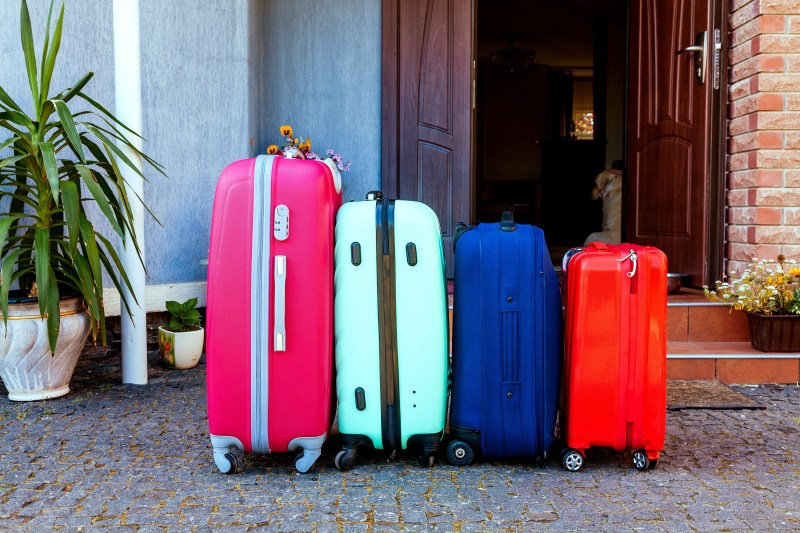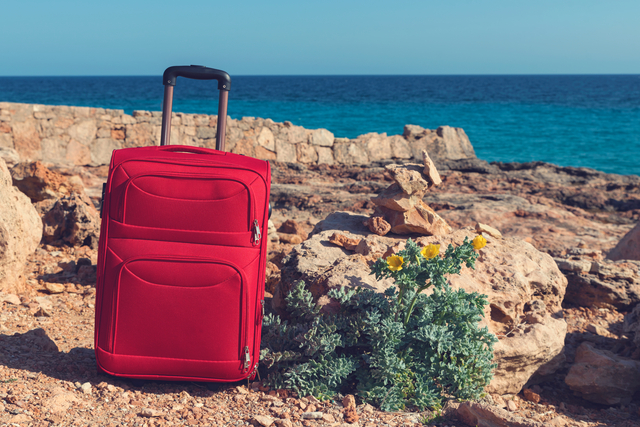
From your bedroom to the street, the airport floors, and the belly of the plane, your luggage has seen it all. Both the inside and the outside of your baggage take quite a beating as you travel from place to place. Many people choose to replace their luggage as soon as it starts to show signs of wear. However, good-quality luggage can last over a decade if cared for properly. These are the steps you need to take to get your suitcases looking as good as new (and make them stay that way).

Cleaning hard shell luggage
Cleaning your hard shell luggage is a fairly straightforward process, and you will only need a few simple materials.
Supplies
The supplies you will need are:
- Mild detergent or dish soap
- Soft cloths or sponges
- A toothbrush or soft-bristle brush
- Towels
- Warm water
Instructions
- To begin, you will want to remove any loose dirt or dust that is on your travel bag. Running a soft cloth or a brush along the outside of your suitcase will give you a good surface to work on and prevent any scratching during the cleaning process.
- Next, you will want to prepare your cleaning solution by mixing a small amount of mild detergent or dish soap with warm water. Before applying the solution to the entirety of your luggage, test a small, inconspicuous area, such as the bottom of the suitcase, to ensure that it doesn’t cause any discoloration or damage.
- Once you have done your test, you can dip your sponge or cloth into the solution and gently wipe down the exterior of your luggage. You can use a toothbrush or a soft-bristle brush for smaller, hard-to-reach areas such as seams, corners, and crevices. Throughout this entire process, you will want to make sure you are being gentle to prevent any scratching.
- If you have any scratches in your suitcase, you can apply a paste of equal parts toothpaste, baking soda, and water on the affected areas. Gently rubbing the paste with a damp cloth should remove the scratches from your luggage.
- After wiping down your case with the soapy solution, repeat the process once more with regular water to remove any soap residue.
- Then, you can use clean, dry towels to dry the luggage thoroughly.

Cleaning soft-sided luggage
Cleaning soft-sided luggage is slightly different than cleaning hard-shell luggage, as the materials are fabric-based and may need a bit more attention and care to get pesky stains out.
Supplies
The supplies you will need are:
- Mild detergent or dish soap
- Soft cloths or sponges
- Warm water
- Hair dryer (optional)
- Fabric protector spray
Instructions
- Just like the hard shell luggage, you will want to start with a mixture of warm water and mild detergent or dish soap. If you are only in need of spot cleaning, you can gently blot the affected areas with a soft cloth or sponge. If your travel bags need a more thorough overall cleaning, then you can once again scrub the entire surface of the bag with your cloth or sponge.
- After you wipe the suitcase down with a damp, soap-free cloth, you will want to place the luggage in a well-ventilated area to dry.
- To speed up this process, you can set a hair dryer on a low temperature and fan it over the entire suitcase.
- Once your luggage dries, you can apply a fabric protector spray to help keep your bag stain-free and safe from water in the future.

How to clean the interior of your luggage
Once you have taken care of the outside of your travel bags, you can get started on the inside. You will want to make sure that your suitcase is completely empty. If there’s any dirt or debris inside of your luggage, you can use a vacuum cleaner to remove it. Then, you can take the same soap and water mixture as before and scrub down the area. For more prominent stains, you can use upholstery shampoo.
After rinsing the interior with a damp cloth to remove any detergent residue, keep the suitcase open and allow it to air dry to prevent any mold or mildew growth.

Taking care of the wheels and handles
Excessive debris in the wheels and handles of your luggage can cause scratching and break down your suitcase faster than normal. Make sure that your wheels are free of any hair, gravel, mud, or other debris before you begin the cleaning process. Then, you can use a disinfecting wipe or microfiber cloth and an all-purpose cleaner to gently wipe down your wheels and handles.
If your suitcase’s wheels are squeaky or stiff, you can apply a silicone-based lubricant to the axles, which will keep the wheels running smoothly.

Storing your luggage and keeping it clean
Although cleaning your luggage is incredibly important, it is even more essential to store your bags properly and take preventative measures to keep them in pristine condition. The best place to store your travel bags is somewhere that is free from moisture, such as under a bed or inside of a closet. If you must store your suitcase in a place that is more prone to moisture, such as a garage or a basement, then consider investing in a luggage cover. You can also keep luggage covers on while you are traveling, as they will keep your bag free from the bumps and knocks of flying.
Additionally, you will want to leave your suitcase partially unzipped to allow your luggage to breathe. If you want to go the extra mile, then throw in a bar of soap or cotton ball soaked in essential oils to keep your bag smelling great.
Overall, regular maintenance and cleaning will help to prolong the life of your hard shell and soft sided luggage. Also, you will want to make sure that you are following the care instructions provided by the manufacturer to ensure you don’t damage any fabric or special coatings that your bags may have.



